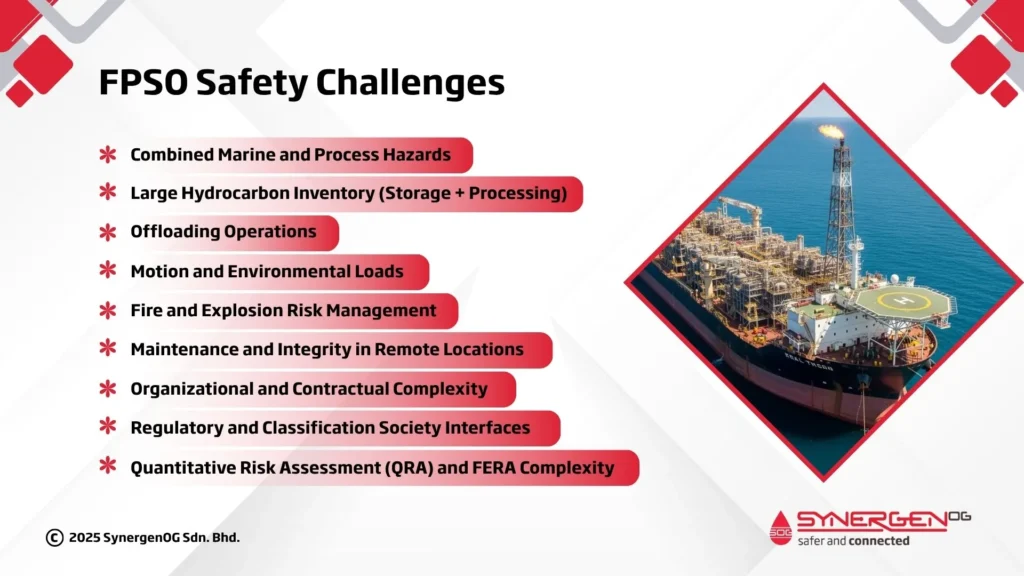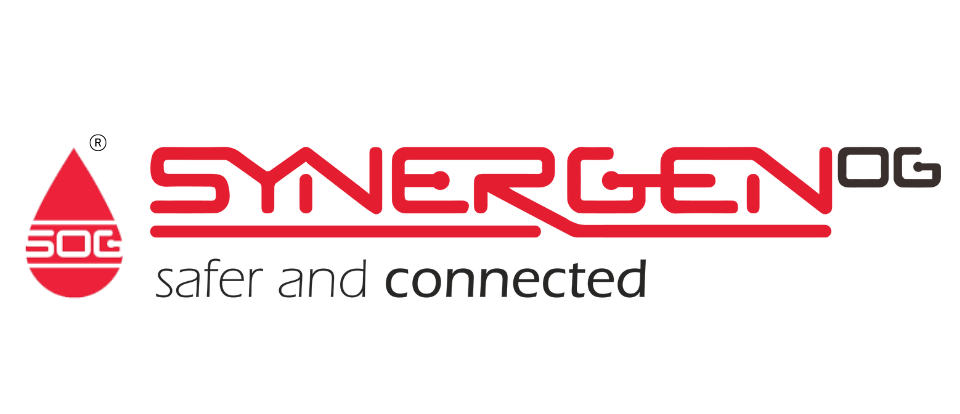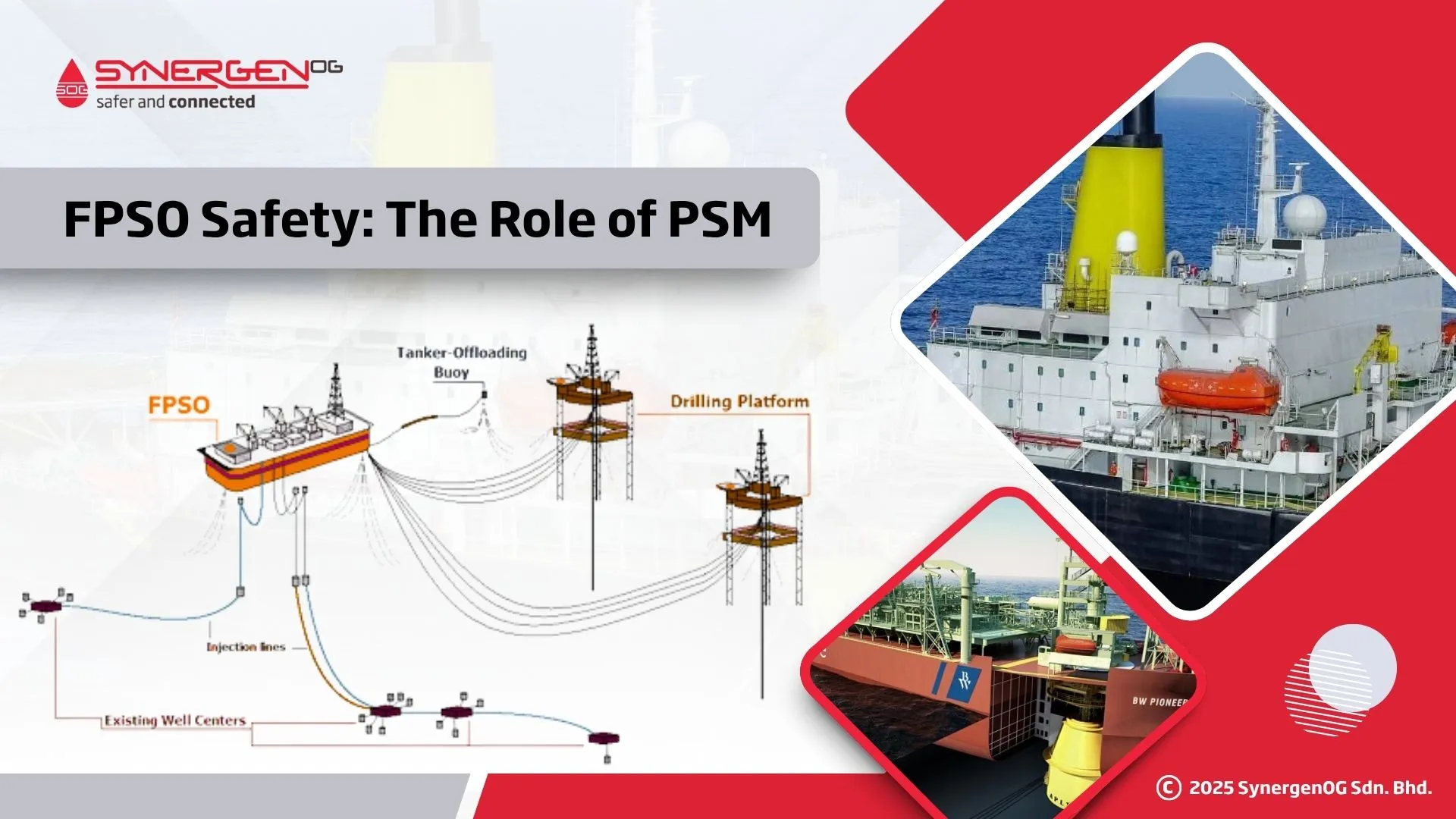| Summary: This article breaks down how to make FPSOs safer by treating process, marine, and storage/offloading risks as one system. Starting from MAHs and bow-ties, we show how to set SCEs that cover cargo tanks and inerting, turret/moorings, risers, DP/drive-off, and shuttle-tanker SIMOPS. We outline practical MOC/SIMOPS controls, proof of barrier health via testing, drills, monitoring, and KPIs, and how to stay aligned with SOLAS/ISM/MARPOL, class, and regional rules—so ALARP and uptime go hand in hand. |
Floating Production, Storage and Offloading units (FPSOs) combine a hydrocarbon process plant with large crude storage and marine/offtake operations—so their major accident hazards (MAHs) span topsides processing (loss of primary containment, overpressure, fires/explosions), turret/swivel transfer, cargo tanks, offloading, mooring and risers. FPSO turret systems, which route production fluids through swivels, are frequently identified as high-risk areas in industry assessments and literature.
FPSO PSM goes beyond standard offshore practice by unifying process, marine, and storage/offloading risks into a single barrier-centric system. Let’s have a look into the safety challenges on FPSOs.
Why PSM matters on FPSOs

1. Combined Marine and Process Hazards
Challenge: FPSOs integrate hydrocarbon processing with marine operations (propulsion, mooring, offloading, navigation systems).
- Interface Risks: Interactions between topside process systems and marine systems (e.g., power, ballast, mooring) can lead to complex failure modes.
- Loss of Station Keeping: Risks from mooring failure, turret bearing issues, or dynamic positioning loss can result in escalation of process hazards (e.g. riser rupture, collision).
- Regulatory Overlap: Managing both maritime and offshore process safety regimes (e.g. SOLAS, MARPOL vs. OHS/process safety standards like ISO 17776, API RP 75, or local regulations).
2. Large Hydrocarbon Inventory (Storage + Processing)
Challenge: FPSOs store large volumes of crude oil on board — often >1 million barrels.
- Fire and Explosion Risk: Extremely high potential energy content; jet fires or pool fires can propagate across storage and process areas.
- Inventory Management: Requires robust systems for level control, inert gas management, and venting to avoid overpressure or vapor cloud formation.
- EER (Escape, Evacuation, Rescue) Complexity: Explosion/fire scenarios may simultaneously affect multiple zones (processing + accommodation + storage).
3. Offloading Operations
Challenge: Regular transfer of crude to shuttle tankers introduces transient hazards.
- Collision and Dropped Object Risks: During tandem or side-by-side offloading, collision can lead to catastrophic loss of containment.
- Simultaneous Operations (SIMOPS): Offloading overlaps with ongoing production, maintenance, and marine operations — requiring tight procedural and operational control.
- Hydrocarbon Release During Transfer: Flexible hose failure or disconnection can lead to major spills or fires.
4. Motion and Environmental Loads
Challenge: Vessel motions (heave, roll, pitch) affect both process and safety systems.
- Instrumentation and Control: Process sensors and control valves can be affected by motion; false readings may compromise shutdown logic.
- Structural Fatigue: Dynamic loads on risers, supports, and flare stacks can increase risk of failure.
- Containment and Drainage: Motion affects drainage patterns and emergency response effectiveness (e.g. firefighting foam coverage).
5. Fire and Explosion Risk Management
Challenge: Congested topsides and proximity between process, storage, and accommodation areas.
- Blast and Fire Segregation: Limited space restricts separation distances and blast wall design options.
- Ventilation & Gas Detection: Difficult to maintain effective detection and ventilation in enclosed or semi-enclosed modules exposed to weather.
- Active Protection Systems: Need for highly reliable deluge, foam, and ESD systems that operate under marine conditions.
6. Maintenance and Integrity in Remote Locations
Challenge: FPSOs often operate far from shore for long campaigns (up to 20–25 years).
- Deferred Maintenance: Space and resource constraints make full shutdowns difficult.
- Aging and Corrosion: Higher humidity, marine atmosphere, and long exposure times increase corrosion and integrity issues.
- Access and Logistics: Limited spare parts and access complicate mechanical integrity programs.
7. Organizational and Contractual Complexity
Challenge: FPSOs are often leased and operated by contractors (e.g., SBM, MODEC) while owned by oil companies.
- Split Responsibilities: Ambiguity between duty holder, operator, and contractor can create gaps in PSM accountability.
- Safety Management Systems Alignment: Need to align marine Safety Management System (ISM Code) with process safety frameworks (e.g., API RP 754, CCPS).
8. Regulatory and Classification Society Interfaces
Challenge: Overlap between maritime classification (ABS, DNV, Lloyd’s Register) and national offshore safety regulators.
- Different Risk Tolerability Criteria: Marine rules focus on hull integrity and stability; process safety focuses on loss of containment and escalation prevention.
- Documentation and Compliance Burden: Managing verification schemes, safety cases, and class certifications concurrently.
9. Quantitative Risk Assessment (QRA) and FERA Complexity
Challenge: Integrate marine and process hazards in one QRA/FERA—capturing cross-escalation—while keeping models accurate, data gaps managed, and run times practical for design and approval.
- Multiple Hazard Domains: Must account for marine accidents (collision, foundering) and process accidents (fires, explosions).
- Fire and Explosion Modeling: Complex geometry and large inventory make modeling scenarios (especially combined ones) computationally intensive.
Core PSM framework for FPSOs
Leadership, policy & ALARP
PSM begins with leadership defining acceptable risk and ensuring “good practice” is followed—e.g., UK HSE’s Assessment Principles and Safety Case guidance emphasize demonstrating relevant good practice and suitability of safety-critical elements (SCEs).
Hazard Identification Tailored to FPSOs
Use HAZID/HAZOP/LOPA to map threats and consequences, but bow-tie analysis is particularly useful offshore to visualize preventive and mitigative barriers from causes to top events and outcomes.
Define SCEs and Performance Standards
SCEs are parts of the facility whose failure could cause or worsen an MAH, or that prevent/mitigate it; their performance standards should be measurable and auditable (functionality, availability, reliability, survivability). UK HSE and Energy Institute publications give concrete expectations and lifecycle practices for SCE management on offshore installations.
Barrier Management & Impairment Control
Barrier health must be assured and verified; inspectors look for evidence that SCEs remain “in good repair and condition,” and for robust verification schemes aligned to legislation. Build dashboards that track impairments/overrides, overdue tests, and verification findings.
Management of Change (MOC) – Technical & Organizational
OSHA PSM (29 CFR 1910.119(l)) requires written MOC procedures for changes to chemicals, technology, equipment, procedures, and facilities that affect a covered process; OSHA has clarified that organizational changes can trigger MOC review.
Procedures & SIMOPS (Simultaneous Operations)
FPSOs routinely conduct SIMOPS—offloading, campaign maintenance, well work, subsea construction—creating interaction risks. Industry guidance (IMCA and others) defines SIMOPS as “performing two or more operations concurrently” and sets out hazard identification, interface management, and permitting expectations; many operators use bridging documents to align contractors.
Permit to Work (PTW): HSE’s HSG250 remains a cornerstone for energy-sector PTW systems, including isolation and override controls integral to barrier integrity.
Competence & Contractors
OSHA PSM requires operator training (initial and refresher) and sets explicit duties for contractors (hazard instructions, training records, adherence to site rules). Offshore SEMS likewise demands competence and contractor oversight.
Mechanical Integrity
PSM demands proactive integrity programs for static/mechanical equipment; for FPSOs also include hull structure, moorings, risers, swivels. DNV standards and recommended practices (e.g., DNV-OS-E301 Position Mooring; DNV-RP-F206 Riser Integrity Management) set accepted criteria for design, monitoring, and in-service assurance.
Emergency Response: ESD, Blowdown, Firewater/deluge
Emergency shutdown and depressuring should follow API Standard 521 principles for relieving and vapor depressuring systems and flare design; fire/gas detection reliability can be evaluated using ISA TR84.00.07. Fixed water-spray/deluge systems should meet NFPA 15 requirements, integrated with marine fire protection obligations under SOLAS/FSS Code.
Incident Investigation & Learning
Your safety case/SEMS should require incident investigation and corrective action tracking; BSEE’s SEMS II strengthened audit and CAP requirements offshore.
KPIs & Governance
Use API RP 754 leading/lagging indicators to track Loss of Primary Containment (LOPC) by tier and safety system challenges; combine with barrier impairment KPIs for an actionable dashboard.
In one sentence: Build a closed-loop system—identify MAHs, define SCEs/performance standards, assure barriers, control changes/SIMOPS, maintain competence, and measure what matters.
Compliance & Class
Global Marine Baseline
- SOLAS (fire protection, drills; inert gas rules via FSS Code) and ISM Code (safety management standard) apply where FPSOs are treated as ships or where owners adopt them for good practice; flag/Coastal State determine scope.
Classification & Technical Rules
- ABS Rules for Floating Production Installations and DNV rules & standards provide FPSO design, class, survey, and SCE testing expectations.
Regional Lenses
- UK North Sea: Safety Case Regulations – duty holders must identify SCEs and set performance standards; HSE guidance (L30/SCR) and inspector notes on SCE suitability and verification are key.
- U.S. GoM: BSEE SEMS mandates a management system, audits, and CAPs; Subpart S details expectations.
- Brazil: NR-13 covers boilers, pressure vessels, piping, and tanks (integrity requirements); NR-20 addresses work with flammables, including training classes.
Australia (NOPSEMA): Safety case regime with defined assessment time frames (e.g., 90 days for new cases, 30 days for revisions) and guidance on content/validation.
Marine Operations & Offtake
- OCIMF’s (Oil Companies International Marine Forum) Guidelines on the Marine Assessment of F(P)SOs complement ISGOTT (International Safety Guide for Oil Tankers and Terminals) for offtake risk controls and marine competence.
Read:Global Safety Case Regulations
New Build Vs Retrofit FPSO – PSM Focus Comparison

| Lifecycle Stage | New-Build FPSO – PSM Focus | Retrofit FPSO – PSM Focus |
|---|---|---|
| Concept / FEED |
|
(e.g., API RP 2FPS, DNV-OS-A101). |
| Detailed Design |
|
|
| Construction & Commissioning |
|
|
| Operation |
|
|
SynergenOG’s Integrated Safety and Risk Assessment Expertise for FPSO Safety Challenges
The base PSM duty is the same globally – to prevent or minimize catastrophic releases – but for FPSO PSM execution, it must reflect marine regulations (SOLAS/ISM), offshore safety case regimes, and classification rules. In the U.S. Gulf of Mexico (GoM), BSEE’s SEMS regulation (30 CFR 250 Subpart S) codifies management-system controls offshore. In the UK North Sea and Australia, regulators require safety cases that identify MAHs and demonstrate that risks are reduced to ALARP with effective barriers and verification.
FPSO Safety Challenges vs SynergenOG’s Capabilities
Combined Marine & Process Hazards
- HAZID workshops to identify cross-domain risks (mooring, risers, power, ballast, process systems)
- Bow-Tie analysis to map marine–process escalation pathways and barriers
- Integrated marine/process risk frameworks for station-keeping and loss of containment scenarios
Large Hydrocarbon Inventory (Storage + Processing)
- FERA to assess pool/jet fire, explosion, and escalation potential across storage and processing areas
- QRA to evaluate high-consequence scenarios and protective system performance
- ALARP demonstration for inventory management controls, venting, and inerting
Offloading Operations & SIMOPS Risk
- SIMOPS risk assessments covering tanker approach, hose handling, and concurrent production activities
- Dropped object and collision risk modelling
- Operational ALARP demonstrations for offloading procedures and emergency disconnect management
Motion & Harsh Environmental Conditions
- Risk reviews considering FPSO motion impacts on instrumentation, ESD logic, drainage, and firefighting
- Bow-Tie analysis for riser, turret, and hull stress events triggered by wave/wind loading
- Emergency response assessments accounting for weather and vessel movement
Fire & Explosion Risk Management in Congested Layouts
- Fire explosion modelling for enclosed/semi-enclosed modules and tight spacing
- Performance review of ESD, deluge/foam, ventilation, gas detection, and blast protection
- Hazardous area studies and ignition control strategy assessment
Maintenance & Integrity in Remote Locations
- Safety Case development supporting long-term asset integrity and risk-based maintenance
- HAZID & bow-ties for aging and corrosion threats, long-campaign shutdown constraints
- Reliability & availability reviews for critical safety systems
Organizational & Contractual Interfaces
- Safety management system alignment between owner, operator, and marine contractor
- Bow-Tie roles & responsibility mapping for duty-holder clarity
- HSE performance standards and assurance framework development
Regulatory & Classification Interfaces
- Safety Case preparation aligned with local regulator and class society expectations
- Verification scheme development bridging maritime and offshore regulatory regimes
- Interface documentation for SOLAS / MARPOL / API / ISO compliance
Complex QRA & FERA Requirements
- Integrated FPSO-specific QRA/FERA covering marine + process hazards & cross-escalation
- Computational fire/explosion modelling for large storage & module congestion
- Transparent ALARP demonstration and justification for design and operations
Conclusion
PSM on FPSOs must go beyond “standard” offshore practice by fusing process, marine, and storage/offloading risks into one barrier-centric system. Build it from MAHs and bow-ties that explicitly cover cargo tanks, inert gas and overfill protection, turret/mooring integrity, risers, dynamic positioning/drive-off, and tandem/offtake SIMOPS with shuttle tankers. Define SCEs and performance standards that include marine-critical elements (hull/structural integrity, stability/ballast management, cargo handling/inerting, offloading ESD/quick-release, foam/deluge and CCR/TR protection) alongside process safeguards (HIPPS, ESD, relief/flare).
Enforce tight MOC and SIMOPS governance for changes affecting class, flag, mooring/offloading windows, and subsea tie-ins. Prove barrier health with function tests, drills (including offloading fire/drive-off scenarios), condition monitoring (hull, mooring, risers), and KPIs that couple API RP 754 with marine leading/lagging indicators (e.g., loss of station, cargo overfill alarms, hawser/QLC activations).
Keep alignment across SOLAS/ISM/MARPOL/Load Line, flag state and class (ABS/DNV), and regional regimes (UK Safety Case, US BSEE SEMS, Brazil NR-13/20, Australia NOPSEMA). The payoff is demonstrable ALARP for the combined process–marine envelope and higher operational reliability during storage and offloading.


